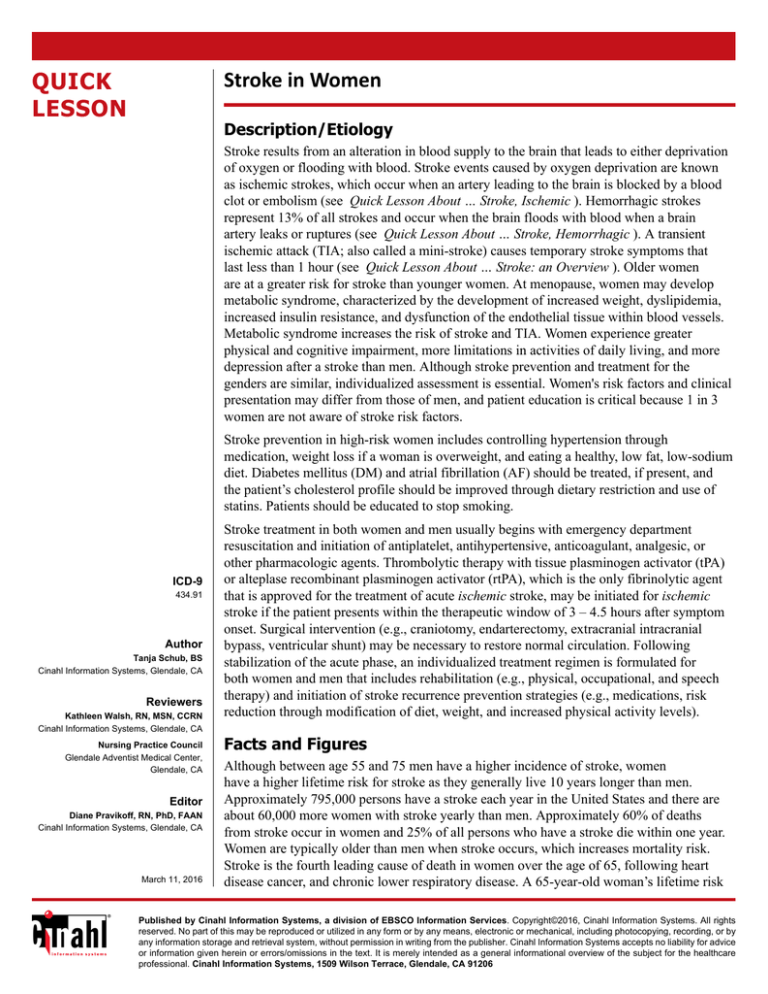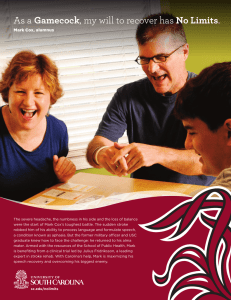
QUICK
LESSON
Stroke in Women
Description/Etiology
Stroke results from an alteration in blood supply to the brain that leads to either deprivation
of oxygen or flooding with blood. Stroke events caused by oxygen deprivation are known
as ischemic strokes, which occur when an artery leading to the brain is blocked by a blood
clot or embolism (see Quick Lesson About … Stroke, Ischemic ). Hemorrhagic strokes
represent 13% of all strokes and occur when the brain floods with blood when a brain
artery leaks or ruptures (see Quick Lesson About … Stroke, Hemorrhagic ). A transient
ischemic attack (TIA; also called a mini-stroke) causes temporary stroke symptoms that
last less than 1 hour (see Quick Lesson About … Stroke: an Overview ). Older women
are at a greater risk for stroke than younger women. At menopause, women may develop
metabolic syndrome, characterized by the development of increased weight, dyslipidemia,
increased insulin resistance, and dysfunction of the endothelial tissue within blood vessels.
Metabolic syndrome increases the risk of stroke and TIA. Women experience greater
physical and cognitive impairment, more limitations in activities of daily living, and more
depression after a stroke than men. Although stroke prevention and treatment for the
genders are similar, individualized assessment is essential. Women's risk factors and clinical
presentation may differ from those of men, and patient education is critical because 1 in 3
women are not aware of stroke risk factors.
Stroke prevention in high-risk women includes controlling hypertension through
medication, weight loss if a woman is overweight, and eating a healthy, low fat, low-sodium
diet. Diabetes mellitus (DM) and atrial fibrillation (AF) should be treated, if present, and
the patient’s cholesterol profile should be improved through dietary restriction and use of
statins. Patients should be educated to stop smoking.
ICD-9
434.91
Author
Tanja Schub, BS
Cinahl Information Systems, Glendale, CA
Reviewers
Kathleen Walsh, RN, MSN, CCRN
Cinahl Information Systems, Glendale, CA
Nursing Practice Council
Glendale Adventist Medical Center,
Glendale, CA
Editor
Diane Pravikoff, RN, PhD, FAAN
Cinahl Information Systems, Glendale, CA
March 11, 2016
Stroke treatment in both women and men usually begins with emergency department
resuscitation and initiation of antiplatelet, antihypertensive, anticoagulant, analgesic, or
other pharmacologic agents. Thrombolytic therapy with tissue plasminogen activator (tPA)
or alteplase recombinant plasminogen activator (rtPA), which is the only fibrinolytic agent
that is approved for the treatment of acute ischemic stroke, may be initiated for ischemic
stroke if the patient presents within the therapeutic window of 3 – 4.5 hours after symptom
onset. Surgical intervention (e.g., craniotomy, endarterectomy, extracranial intracranial
bypass, ventricular shunt) may be necessary to restore normal circulation. Following
stabilization of the acute phase, an individualized treatment regimen is formulated for
both women and men that includes rehabilitation (e.g., physical, occupational, and speech
therapy) and initiation of stroke recurrence prevention strategies (e.g., medications, risk
reduction through modification of diet, weight, and increased physical activity levels).
Facts and Figures
Although between age 55 and 75 men have a higher incidence of stroke, women
have a higher lifetime risk for stroke as they generally live 10 years longer than men.
Approximately 795,000 persons have a stroke each year in the United States and there are
about 60,000 more women with stroke yearly than men. Approximately 60% of deaths
from stroke occur in women and 25% of all persons who have a stroke die within one year.
Women are typically older than men when stroke occurs, which increases mortality risk.
Stroke is the fourth leading cause of death in women over the age of 65, following heart
disease cancer, and chronic lower respiratory disease. A 65-year-old woman’s lifetime risk
Published by Cinahl Information Systems, a division of EBSCO Information Services. Copyright©2016, Cinahl Information Systems. All rights
reserved. No part of this may be reproduced or utilized in any form or by any means, electronic or mechanical, including photocopying, recording, or by
any information storage and retrieval system, without permission in writing from the publisher. Cinahl Information Systems accepts no liability for advice
or information given herein or errors/omissions in the text. It is merely intended as a general informational overview of the subject for the healthcare
professional. Cinahl Information Systems, 1509 Wilson Terrace, Glendale, CA 91206
of stroke is 1 in 5. One-quarter of women who have a stroke are < 65 years. The reported risk of stroke in pregnancy is
threefold. Incidence of subarachnoid hemorrhage, a type of hemorrhagic stroke is reported to have recently increased in
postmenopausal women. More than 25% of women with stroke report atypical (also called nontraditional) symptoms,
including pain and non-neurologic symptoms. Post-stroke disability is typically greater in women than in men, which
negatively affects the ability to function independently.
Risk Factors
Although many risk factors apply to both men and women (see the Quick Lesson referenced above for risk factors common
to both genders), some risk factors are unique to women, such as sleep deprivation, depression, taking oral contraceptives
(especially if combined with smoking), pregnancy, having a wide waist (e.g., postmenopausal waist larger than 35.2 inches),
elevated triglyceride levels, migraine headaches, and having DM.
Pregnant women are at increased risk for ischemic stroke and intracerebral hemorrhage. Prenatal stroke is also associated with
pre-eclampsia, eclampsia, and premature delivery.
In the U.S., Black women are twice as likely as White women to have a stroke due in part to the high prevalence of
hypertension, DM, and sickle cell anemia in the Black population. Postmenopausal women who experience acute myocardial
infarction (AMI) are at high risk for stroke independent of hormone replacement therapy (HRT) use. Taking HRT to relieve
menopausal symptoms may be a risk factor for stroke.
Signs and Symptoms/Clinical Presentation
Men and women share common stroke symptoms (for details, see the Quick Lesson referenced above), but women often
experience additional symptoms, all of which typically occur suddenly and include facial and extremity pain, hiccups, nausea,
general weakness, chest pain, shortness of breath, and palpitations. Women are less likely than men to report difficulty
walking, balance problems, or dizziness when experiencing a stroke. Men present without any stroke warning signs more often
than women.
Assessment
› Patient History
• Assess for modifiable and non-modifiable stroke risk factors
› Physical Findings of Particular Interest
• Depressed level of consciousness and elevated blood pressure may indicate hemorrhagic stroke; if neurological deficits
improve rapidly, stroke may be ischemic
› Laboratory Tests That May Be Ordered
• Serum cholesterol, HgA1c, C-reactive protein (CRP), and homocysteine levels may be elevated or otherwise abnormal;
coagulation studies may be abnormal
› Other Diagnostic Tests/Studies
• ECG will identify AF or other cardiac abnormalities
• Carotid ultrasonography will identify the degree of carotid artery obstruction
• MRI will identify the area of stroke, aneurysms, arteriovenous malformations, and blocked blood flow
• Computerized tomographic angiography (CTA) will show 3-dimensionalimages of aneurysms, arteriovenous
malformations, and narrowing of arteries
• CT scan may indicate hemorrhagic stroke
• Arteriography may indicate locations of plaque deposits or arterial narrowing
Treatment Goals
› Stroke is a medical emergency . The American Heart Association (AHA) has developed a mnemonic device (the seven
“D’s” of stroke care) to quickly evaluate patients to determine if they are candidates for fibrinolytic therapy: D etection
(early recognition), D ispatch (rapid intervention), D elivery (advance prehospital notification and transport), D oor
(rapid triage), D ata (assessment, testing, and evaluation completed within 45 minutes of arrival at hospital), D ecision
(determination of candidacy for fibrinolytic therapy), and D rug (initiation of pharmacologic therapy)
› For more information on stroke treatment, see the Quick Lesson, referenced above
Food for Thought
› Research on HRT and stroke in perimenopausal and menopausal women has been inconclusive as to whether use of HRT
increases the risk of stroke; HRT is not indicated for stroke prevention, and its use in treating menopausal symptoms should
be weighed against potential side effects
› Adherence to a Mediterranean-type (i.e., high in monounsaturated fats, plant proteins, whole grains, and fish; moderate
alcohol intake; and low in red meat, refined grains, and sweets) is associated with reduced risk of stroke in women
› Stroke is the fifth leading cause of death in men due to efforts by the American Heart Association/American Stroke
Association related to improved prevention and improved care in the first few hours after symptoms occur. However, in
women it is third behind cardiovascular disease and cancer
› More education on recognizing stroke warning signs and symptoms is needed, especially in minority communities
Red Flags
› Women over age 35 who smoke and women who have had previous thromboembolism should not take oral contraceptives
because of the increased risk of stroke
› When compared to men, women with acute stroke experience longer delays in the emergency department. This difference
has not been shown to be attributable to differences in presenting symptoms or age. Women are less likely than men to
receive tPA for acute stroke
What Do I Need to Tell the Patient/Patient’s Family?
› Advise patient that stroke survivors are at high risk for recurrent stroke, and it is critical to adhere strictly to the medical
surveillance schedule and treatment regimen (e.g., medication compliance, physical/occupational therapy, lifestyle
modification)
› Discuss risk reduction measures, including smoking cessation, alcohol reduction/avoidance, regular exercise, weight loss
if overweight, maintaining a normal blood pressure (by lifestyle choices and/or medication) and eating a healthy diet that
includes monounsaturated fats (i.e., olive oil) fish and vegetable proteins, and high fiber
› Educate about unique stroke symptoms in women; emphasize the importance of seeking immediate medical attention for
new or worsening symptoms
References
1. Bushnell, C., & McCullough, L. (2014). Stroke prevention in women: Synopsis of the 2014 American Heart Association/American Stroke Association Guideline. Annals of
Internal Medicine, 160(12), 853-857. doi:10.7326/M14-0762
2. Bushnell, C., McCullough, L. D., Awad, I. A., Chireau, M. V., Fedder, W. N., Furie, K., ... Walters, M. R. (2014). Guidelines for the prevention of stroke in women: A statement
for healthcare professionals from the American Heart Association/American Stroke Association. Stroke, 45(5), 1545-1588. doi:10.1161/01.str.0000442009.06663.48
3. Diep, L., Kwagyan, J., Kurantsin-Mills, J., Weir, R., & Jayam-Trouth, A. (2010). Association of physical activity level and stroke outcomes in men and women: a meta-analysis.
Journal of Women's Health, 19(10), 1815-1822. doi:10.1089/jwh.2009.1708
4. Ennen, K. A. (2013). Taking a second look at stroke in women. American Nurse Today, 8(5), 12-14.
5. Godfrey, J. R., & Sacco, R. L. (2009). Conversation with the experts. Toward optimal health: A renewed look at stroke in women. Journal of Women's Health, 18(1), 13-18.
doi:10.1089/jwh.2008.1244
6. Jauch, E. C., Saver, J. L., Adams, H. P., Brunn, A., Connors, J. J., Demaerschalk, B. M., ... Yonas, H. (2013). Guidelines for early management of patients with acute
ischemic stroke: A guideline for healthcare professionals from the American Heart Association/American Stroke Association. Stroke, 44(3), 870-947. doi:10.1161/
STR.0b013e3333318284056a
7. Miller, J., & Mink, J. (2009). Acute ischemic stroke: Not a moment to lose. Nursing 2009, 39(5), 37-43. doi:10.1097/01.NURSE.0000350755.49282.6a
8. Scott, C. A., Bewley, S., Rudd, A., Spark, P., Kurinczuk, J. J., Brocklehurst, P., & Knight, M. (2012). Incidence, risk factors, management, and outcomes of stroke in pregnancy.
Obstetrics & Gynecology, 120(2 part 1), 318-324. doi:10.1097/AOG.0b013e31825f287c





